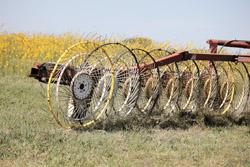 If you’re tired of replacing broken or bent teeth on V or side delivery hay rakes, you’ll be interested in these new molded poly straps that bolt together to form a hoop to surround the rake wheel.
If you’re tired of replacing broken or bent teeth on V or side delivery hay rakes, you’ll be interested in these new molded poly straps that bolt together to form a hoop to surround the rake wheel.
The VRTS System stands for V-Rake Teeth Support and was invented by Reg Roth, who ranches and farms near Wolbach, Neb.
“The hoops provide support that allows them to work as designed with minimal bending or breaking. It helps on everything from alfalfa to corn stalks,” says Roth. “The rake actually performs better and leaves windrows that are more uniform. You can apply more down pressure while raking heavy windrows or raking on uneven ground.
“We developed the system because we rake and bale grass hay, alfalfa, rye, forage sorghum, corn stalks, wheat straw and anything else that will make feed for our cattle feeding operation. We had to replace a lot of rake teeth, which cost us time and money.”
The straps are made of high density polyethylene and measure 16 1/4 in. long by 3/4 in. wide. They have a series of holes in them and bolt together with a smooth-shank shoulder bolt through slots at the ends of each strap. Once all the straps are bolted together you thread them onto the rake wheel, one tooth for each hole. When fully threaded on the wheel, install the last bolt to complete the circle. Repeat until the system is installed on all wheels.
It takes 10 or 12 bolted-together straps per wheel to form the hoop, depending on the rake’s make and model and the number of tines on the wheel.
“They work by dispersing pressure from ground contact over 8 or 9 different tines instead of just one. As a result there’s less tine vibration and less chance the tines will break,” says Roth. “The slots allow the hoop to ‘float’ as it moves with the wheel.”
Rakes with 40 tines per wheel require 10 straps. Rakes with 48 tines per wheel require 12 straps.
“If your rake has missing or bent teeth, we recommend that you replace or straighten the teeth before installing the VRTS System. Failure to do this will compromise the effectiveness of the system and may cause unnecessary wear on the straps,” says Roth.
1-800-834-9665
Poly Hoops Keep Hay Rake Teeth From Breaking
FARM SHOW Magazine » Poly Hoops Keep Hay Rake Teeth From Breaking
Poly Hoops Keep Hay Rake Teeth From Breaking
